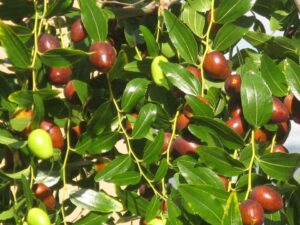Jujube – Zizyphus Sativa

Giuggiolo is a shrubby plant of the genus Ziziphus belonging to the Rhamnaceae family. The origins of the tree are Asian, in particular from India and Southern China, where its extreme sweetness has earned it the nickname of Chinese date. The jujube is an aesthetically beautiful tree and very resistant even to the poorest soils and the driest climates, which reaches a maximum height of about 5/6 meters. The jujube plant has a very slow growth but is very long-lived: just think that millenary jujubes still survive in China today.
GROUND
For the planting of the jujube, the most recommended period is generally the end of winter (February). To favor optimal growth it is important to choose a light, medium organic and above all well drained soil; the plant must have space to develop its root system, so the soil must be deep enough. To grow well, the jujube requires a warm and temperate climate, not excessively humid with full sun exposure. The plant resists well to periods of drought but also to particularly cold days, withstanding temperatures of even 10 ° below zero.
FIORI E FRUTTI
The jujube is a deciduous plant, the leaves have a beautiful deep green color in the upper part, while they are a little greyish in the lower part and have a tendency to germinate very late in spring. Between June and July the inflorescences gradually appear on the jujube, very small and not very showy flowers, formed by a calyx of greenish lobes and a central crown formed by five white-yellow petals. The flowers resist on the jujube until the end of August, attracting bees and other pollinating insects attracted by their nectar: at the end of summer the fruit develops from the flower, that is a fleshy drupe generally roundish the size of an olive, the skin of the fruit is brown reddish and the pulp, yellowish and floury.
USE AND HEALTHCARE CONTENT
Fresh jujubes have a nutritional profile similar to that of figs and dates: in addition to being rich in sugars, they are a source of vitamin C, pro vitamin A and group B vitamins, these precious fruits also provide our body with precious minerals, including which iron, calcium, phosphorus and manganese. Jujubes are in fact used as an emollient, antiseptic, anti-inflammatory and antispastic remedy and are used to ensure the proper functioning of the liver and gastrointestinal system, as well as the urinary, respiratory and cardiovascular systems.
PRUNING AND COLTURAL CARE
As for pruning, during the growth phase of the plant, the interventions must be minimal, to be carried out every 3 years before winter and aimed at eliminating dry, damaged branches or those that are growing crooked.
